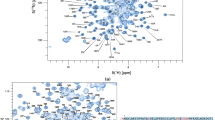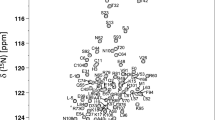Abstract
Growth factor receptor-bound protein 2 (Grb2) is an adaptor protein composed of three domains, an N-terminal SH3 (nSH3), SH2 and a C-terminal SH3 (cSH3) domains. This multi-domain protein has been reported to be a key factor in many signaling pathways related to controlling cell survival, differentiation, and growth. The Grb2-SH2 domain has been a focus for the study of the interaction with peptides and small molecules to act as inhibitors in uncontrolled cell growth, and consequently inhibit tumor proliferation. Here we describe the almost complete assignment of the free SH2 domain at pH 7. This work prepares the ground for further structural studies, backbone dynamics, mapping of interactions and drug screening and development. TalosN secondary structure prediction showed great similarity with the available structures in the PDB.


Similar content being viewed by others
References
Ahmed Z et al (2015) Grb2 monomer-dimer equilibrium determines normal versus oncogenic function. Nat Commun 6:7354
Chardin P et al (1993) Human Sos1: a guanine nucleotide exchange factor for Ras that binds to GRB2. Science 260(5112):1338–1343
Delaglio F et al (1995) NMRPipe: a multidimensional spectral processing system based on UNIX pipes. J Biomol NMR 6(3):277–293
Dhillon AS et al (2007) MAP kinase signalling pathways in cancer. Oncogene 26(22):3279–3290
Gal M et al (2011) Speeding up direct (15)N detection: hCaN 2D NMR experiment. J Biomol NMR 51(4):497–504
Giubellino A, Burke TR, Bottaro DP (2008) Grb2 signaling in cell motility and cancer. Expert Opin Ther Targets 12(8):1021–1033
Grzesiek S, Bax A (1993) Amino acid type determination in the sequential assignment procedure of uniformly 13C/15 N-enriched proteins. J Biomol NMR 3(2):185–204
Hyberts SG et al (2012) Application of iterative soft thresholding for fast reconstruction of NMR data non-uniformly sampled with multidimensional Poisson Gap scheduling. J Biomol NMR 52(4):315–327
Ikura M, Kay LE, Bax A (1990) A novel approach for sequential assignment of 1H, 13C, and 15 N spectra of proteins: heteronuclear triple-resonance three-dimensional NMR spectroscopy. Application to calmodulin. Biochemistry 29(19):4659–4667
Kay LE et al (1993) A gradient-enhanced HCCH-TOCSY experiment for recording side-chain 1H and 13C correlations in H2O samples of proteins. J Magn Reson 101:333–337
Lewitzky M et al (2001) The C-terminal SH3 domain of the adapter protein Grb2 binds with high affinity to sequences in Gab1 and SLP-76 which lack the SH3-typical P-x-x-P core motif. Oncogene 20(9):1052–1062
Lin C et al (2012) Inhibition of basal FGF receptor signaling by dimeric Grb2. Cell 149(7):1514–1524
Logan TM et al (1992) Side chain and backbone assignments in isotopically labeled proteins from two heteronuclear triple resonance experiments. FEBS Lett 314(3):413–418
Lowenstein EJ et al (1992) The SH2 and SH3 domain-containing protein GRB2 links receptor tyrosine kinases to ras signaling. Cell 70(3):431–442
Maciejewski MW et al (2017) NMRbox: a resource for biomolecular NMR computation. Biophys J 112(8):1529–1534
Maignan S et al (1995) Crystal structure of the mammalian Grb2 adaptor. Science 268(5208):291–293
Molina JR, Adjei AA (2006) The Ras/Raf/MAPK pathway. J Thorac Oncol 1(1):7–9
Rozakis-Adcock M et al (1993) The SH2 and SH3 domains of mammalian Grb2 couple the EGF receptor to the Ras activator mSos1. Nature 363(6424):83–85
Sattler M, Schleucher J, Griesinger C (1999) Heteronuclear multidimensional NMR experiments for the structure determination of proteins in solution. Prog Nucl Magn Reson Spectrosc 34:93–158
Senior MM et al (1998) The three-dimensional solution structure of the SRC homology domain-2 of the growth factor receptor-bound protein-2. J Biomol NMR 11(2):153–164
Shen Y, Bax A (2013) Protein backbone and sidechain torsion angles predicted from NMR chemical shifts using artificial neural networks. J Biomol NMR 56(3):227–241
Thornton KH et al (1996) Nuclear magnetic resonance solution structure of the growth factor receptor-bound protein 2 Src homology 2 domain. Biochemistry 35(36):11852–11864
Vranken WF et al (2005) The CCPN data model for NMR spectroscopy: development of a software pipeline. Proteins 59(4):687–696
Wang YS et al (1996) Chemical shift assignments and secondary structure of the Grb2 SH2 domain by heteronuclear NMR spectroscopy. J Biomol NMR 7(2):89–98
Wittekind M, Mueller L (1993) HNCACB, a high-sensitivity 3D NMR experiment to correlate amide-proton and nitrogen resonances with the alpha-and beta-carbon resonances in proteins. J Magn Reson 101:201–205
Zhang YZ (1995) Protein and peptide structure and interactions studied by hydrogen exchange and NMR. Dissertation
Acknowledgements
This work was supported by FAPESP Grants Nos. (2014/17630-0, 2017/20642-8), CNPq Grants No. 442951/2014-0, UNESP-PROPG Grants Nos. (09/2017, 12/2017) awarded to FAM; FAPESP Grants No. 2009/53989-4; and by FAPERJ Grants Nos. (239229, 204432) and CNPq Grants No. 309564/2017-4 awarded to FCLA. We thank NMRbox: National Center for Biomolecular NMR Data Processing and Analysis, a Biomedical Technology Research Resource (BTRR), which is supported by NIH Grants No. P41GM111135 (NIGMS). We also thank INBEB-INCT for funding. The assignment was deposit at the Biomagnetic Resonance Data Bank (BMRB ID 27781). KS is funded by CNPq scholarship (131968/2017-3) and IPC is funded by a postdoctoral fellowship by FAPERJ.
Author information
Authors and Affiliations
Corresponding authors
Ethics declarations
Conflict of interest
The authors declare that they have no conflict of interest.
Additional information
Publisher's Note
Springer Nature remains neutral with regard to jurisdictional claims in published maps and institutional affiliations.
Rights and permissions
About this article
Cite this article
Sanches, K., Caruso, Í.P., Almeida, F.C.L. et al. NMR assignment of free 1H, 15N and 13C-Grb2-SH2 domain. Biomol NMR Assign 13, 295–298 (2019). https://doi.org/10.1007/s12104-019-09894-x
Received:
Accepted:
Published:
Issue Date:
DOI: https://doi.org/10.1007/s12104-019-09894-x




